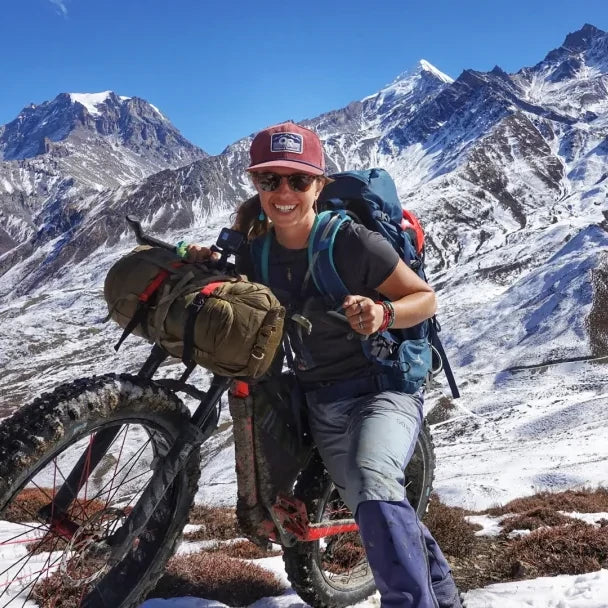Body and Mind Training for Bikepacking
Guest Blog — Elizabeth Sampey: Doctor of Physical Therapy, Adventure Coach, and Pro Bikepacker
As the days get longer, many of us are eager to get our wheels rolling for a season of bikepacking. The beauty of bikepacking is that you can just spontaneously throw your stuff on your bike (and in a backpack if you like) and ride out your back door.
But if you spend some time before your trips preparing yourself for your bikepacking adventures – training your body as well as your mind, preparing logistically, and making sure your bike handling skills are dialed, you’ll be setting yourself up to feel stronger and more confident, prevent injuries, and have the most fun wherever and whenever you choose to ride.
The aspect of adventure training and preparation that most of us tend to think about is our physical body. Am I fit enough, strong enough, capable of doing the miles or keeping up with my friends? Is my body ready for the challenge so I don’t end up injured? These are the questions that, as an adventure coach, physical therapist, and avid bikepacker myself, I hear many people asking.

Photo Credit: Anthony Cupaiuolo
Physical Training Framework: The Seven Elements
The seven elements of physical adventure training that I take into consideration are these: Body-Mind Intelligence, Recovery & Sleep, Rehabilitation, Stability, Mobility, Fuel, and Fitness.
Most people tend to focus only on fitness, and maybe also strength (which is part of stability). But all seven of these are important to consider as you check in with yourself and assess where you’re at and what you need to work on to get your body adventure-ready.
1. Body-Mind Intelligence
What does this mean? I define it as having an open and active line of communication between our bodies and our minds. It’s important that we learn to listen to what our bodies are telling us: does this thing I’m doing feel helpful, or harmful? Does my body feel energized, or exhausted? Does this thing I’m feeling feel like effort, or pain? This element is key to injury prevention and burnout.
2. Recovery and Sleep
This one is simple. If we’re training too hard and not giving our bodies ample time to recover, we’re doing ourselves more harm than good. I always take at least one, sometimes two days off per week. After a few weeks of ramping up training, it’s good to take a full recovery week – for me and the athletes I coach, that means more days completely off, more focus on mobility, more time spent sleeping and resting, and the few rides that do happen are short and easy. It’s also important to get between 7-9 hours of sleep per night on a consistent basis.
3. Rehabilitation
Now is a great time to address any nagging injuries you might have, on your own or with the help of a good sports medicine physical therapist, before you take on any big adventures where ignored issues will become a problem. Sometimes, starting strength and mobility training will help resolve overuse injuries. Pain can happen when our muscles are too weak, too tight, or when our body doesn’t have the mobility to do what we’re asking it to do. But, if after a couple weeks of training your pain starts to get worse, or doesn’t get better, it’s time to seek help.
4. Stability
This includes Strength, Motor Control, and Balance. I do functional training year-round that works all three, and I do the exercises in tabata form with a 2:1 work:rest interval, usually with 4 sets of each lasting 60/40/30/20 seconds. Here are some of my favorites:
5. Mobility
Here is a three-minute video that is a sped-up version of the mobility practice that I do after a ride. It involves active mobility, moving through the positions in a flow, and passive mobility, holding individual positions as long as it feels good, from 30 seconds to a few minutes. The whole thing takes me about 20 minutes.
6. Fuel
The two components of fueling are nutrition and hydration. If you’re doing rides over two hours, it’s important to fuel your body each hour so it can keep going. A good rule of thumb is to start with eating around 200-300 calories per hour of movement, and to revise from there based on your personal needs and the intensity of your riding. Real food—burritos, peanut butter cookies, salty crackers or chips, etc—is best for endurance pursuits as opposed to highly processed bars and gels. And a good rule of thumb for hydration is to start with half a liter (16 oz) per hour, and revise based on your personal needs, intensity, and the temperature.
7. Fitness
The components I include in the “fitness” category are cardiovascular endurance, muscular endurance, speed, power, and agility. All of these are also trained in the functional stability training that I do off the bike, but I design these elements into my on-bike training as well. It’s important to make sure that our fitness training is functional and specific to bikepacking, as it’s quite different from training we might do for shorter and faster rides that don’t involve a loaded bike, hiking our bike, or riding long days in succession.
About the Author
Dr. Eliza Sampey has designed her life around exploring the world’s wildest places through human-powered travel; connecting landscapes by bike, packraft, skis, and foot. She loves competing in self-supported bikepacking races and especially enjoys riding at night. A passionate educator, Liz holds a doctoral degree in physical therapy, and believes adventure has the power to change lives when pursued in a mindful and sustainable way.
Liz proudly rocks Rogue Panda gear in all her biking endeavors. We’re stoked to support her as she continues to represent badass women in the sport of bikepacking.
Follow Liz’s adventures on Instagram.

Follow us on Instagram!

